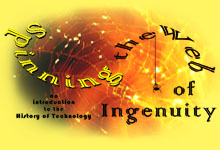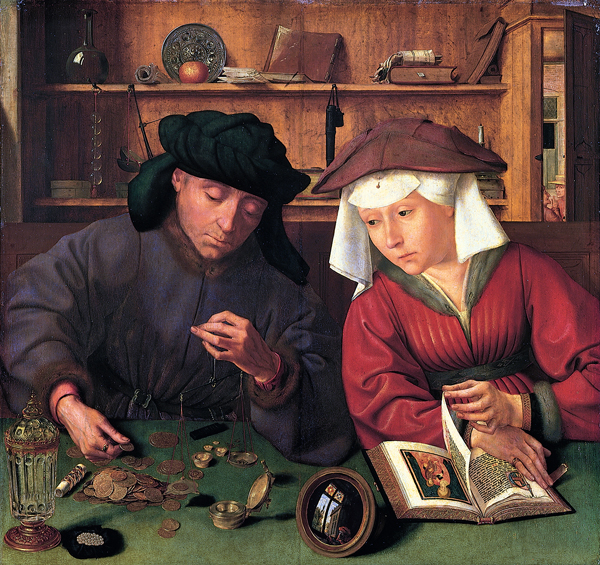
University of California, Irvine
Instructor: Dr. Barbara J. Becker

|
Lecture 8. Gathering Human Resources
|
Mining operations in Saxony were supported by powerful financiers in Augsburg -- the Fuggers, Haugs and Welsers. They sent German craftsmen wherever improvement of mining would increase the yield of a known site. German technicians brought improved pumping machinery to the mines of Spain. They introduced tramways and water-pwered ore crushing machinery in England. Around 1550, the mines in Germany became less profitable. Depleted European mines were challenged by competition with rich, newer mines in the New World. The desire to extract traces of silver in ores of copper and lead mined locally in Europe provided an incentive to develop more refined separating methods. How did the products of mining operations affect the material and social culture of early 16th-century European life? Paintings from the period, like "The Banker [or, Moneychanger] and his Wife" (1514) by Flemish artist Quinten Massys (c. 1465-1530), in the Louvre's collection, provide us with substantive fat and gristle to chew on. |

| In this painting, Massys depicts a resident of Antwerp carefully weighing coins from a pile lying on the table while his wife turns from her prayer
book to watch. The inscription on the original frame for this painting contained a passage in Latin -- "Stature
justa et aequa sint pondere" [Translation: "Use honest scales and honest weights"] -- from Leviticus 19:36.
Is the man a banker, a moneychanger, a pawnbroker? Perhaps all three. Antwerp was a bustling seat of commerce and high finance at the time. The coins on the table are from many different principalities. Each has likely changed hands many times increasing the risk that its original value has been lost through illegal clipping [shaving precious metal from its circumference] or sweating [shaking it in a bag with other coins to collect the resulting gold dust and fragments]. Before accepting, lending or exchanging these coins, each one must be carefully weighed to determine its current value. Does the black velvet pouch filled with pearls (lower left) represent collateral for a loan, or a prized possession to be pawned? What about the collection of bejewelled gold rings on the graduated ringholder placed next to the coins? Is the ornate reliquary seen to the left of the pearls simply another object on the table that derives its worth from its commercial value? Or is it intended to represent (in absentia) St. Eligius (c. 588-660), the patron saint of metalworkers? The image in the convex mirror (bottom center) reveals both the face of the man's client and a large window, the source of the room's light. The client, dressed in red and possibly wearing spectacles, is absorbed in reading a small book held in his right hand. He rests his left hand casually upon the windowsill. Whatever the nature of the business that brought him to this place, he came prepared for a lengthy wait. The client's trust in the man at the table can be inferred from the fact that he does not feel obliged to observe while the coins are weighed. To weigh the coins in front of him, the man at the table grasps a portable pan balance between his left thumb and forefinger. With it, he compares a coin on the flat triangular pan with a square metal standard weight in the rounded pan. Other standard weights are arranged on the table in easy reach, notably the open brass container (or "house") shown in the foreground and the set of four bowl-shaped brass weights (or, "stack of Charlemagne") crafted to nest neatly inside it. But the man seems less focused on the scale than on the coin he holds in his right hand. Do his expert fingers detect signs of clipping? His wife's attention has been torn from her daily prayers to the affairs of the world. She appears transfixed, her whole body and brain momentarily immobilized by some distraction on the other side of the table. Her own left hand is poised in synchrony with her husband's: her thumb and forefinger freeze a page of her prayerbook in mid-turn, as though she feared the whispered breath of its continued motion would upset the perfect balance of the scales. On what, if anything, has she fixed her vacant and almost melancholy gaze? Is she in awe of her husband's care and skill? lost in spiritual reverie over the empty reliquary? wistfully (and sinfully) longing for the pearls? wishing that she -- like the Madonna she resembles in the prayerbook illustration -- had a child to keep her otherwise occupied? or maybe thinking she could do the job better and faster than her husband? Many of the items arrayed on the shelves behind the man and his wife have symbolic meaning that was important to 16th-century patrons of the arts. The apple, for example, serves as a reminder of the Garden of Eden, the snuffed candle is a symbol of death or a loss of inner spiritual light. Why did the artist include the two men seen through the open door? What are they talking about? |
![]()

| 1494 | born, Glauchau, Saxony |
| 1514 | entered University of Leipzig |
| 1518 | teacher/administrator at school in Zwickau |
| 1522 | lecturer at University of Leipzig |
| 1524 | went to Italy (Bologna, Padua and Ferrara)
• studied philosophy and medicine • met humanist, Erasmus (1466-1536) |
| 1526 | returned to Zwickau |
| 1527 | became physician for town of Joachimstal |
| 1530 | published little book on mining terminology |
| 1531 | published pamphlet on the Turks |
| 1533 | published book on weights and measures
began work on De Re Metallica named city physician at Chemnitz |
| 1544 | began work on and published series of books on:
• physical geology • subterranean waters and gases • mineralogy • the history of metals • mineralogical and metallurgical terminology • animals that live underground |
| 1546 | appointed Burgomaster of Chemnitz |
| 1550 | completed De Re Metallica |
| 1555 | died at Chemnitz |
| 1556 | De Re Metallica published |
At the time Agricola began his work on De Re Metallica, natural philosophy, including the study of minerals, was still steeped in the Aristotelian tradition. Adherents reasoned, like Aristotle, that since members of both the animal and vegetable kingdoms propagate by means of seeds given off by their own bodies, there was no cause to doubt that the mineral kingdom shared the same fundamental characteristic. Agricola himself cited an example of iron ore in Elba which replaced itself ten years after being extracted. Aristotelians also believed that base metals mature into nobler ones. Lead ores were frequently found to have some silver embedded in them and silver samples often contained some gold. At the same time, those who embraced emerging alchemical and astrological views supported the notion that upon reaching Earth, emanations originating from the planets seeped into cracks and fissures in the Earth's surface. Each planet would generate its favored metal there. Normal transformation from base metals to purer metals as described by Aristotle would then occur. The seven common metals were related to the seven known planets and their powers:
[Why do you think Earth is not on this list?] All visible rock on the Earth is not made of gold because once a metal reaches the level of pure gold, continued exposure to heavenly exhalations then begins to degrade it again, ultimately leaving only a reddish earthy residue and possibly a few flakes of gold. Mother Earth is analogous to the body of an animal. It requires nourishment from without. It has an arterial and vascular system in the form of seas and rivers for distributing this nourishment. Like all living bodies, it possesses a central fire analogous to an animal's heart: it provides the heat required for life as well as the motive power that keeps internal fluids in motion. Passages and fissures within the Earth connect subterranean rivers and pools of fire. Caverns may fill with air, water, or fire and thus account for the hot springs and volcanoes observed on Earth's surface. The exhalations from fissures can cause plagues and earthquakes. The great economic activity spawned by the Renaissance enabled a scholarly physician like Agricola to enter the mines, study the structure of the Earth's crust and organize his observations into a logical pattern. |
Agricola's contributions:
|
De
Re Metallica (1556)
|
|
Miners need to know:
|
|
Miners must consider:
|
|
Rocks containing ore are older than the ore they contain Breaks in earth's crust are formed by process of erosion by subterranean water Subterranean heat causes water to percolate and form "juices" containing stone and metals Ores are deposited from solutions passing through fissures and voids in the rocks Magnetic compass is very useful for locating mines
|
|
Mining operators lease land from owner (who has right to pasture animals on it) Miners are allowed to tunnel in any direction for unlimited length Mines operate on 24 hr basis, 5 days/week (Monday-Friday)
|
|
Mine shaft requires a sheltered area above opening to protect windlass operators Tunnels should be twice as high as they are wide Vertical shafts should be dug for lifting mined materials out of mine with minimum of carrying along horizontal tunnel |
|
Tools and equipment
Dangers to Miners
|
|
Test samples of ore to identify proportions of each constituent metal Great care is required since result will be multiplied over entire batch and errors increased! |
|
|
|
|
|
|
|
|
|
|
|